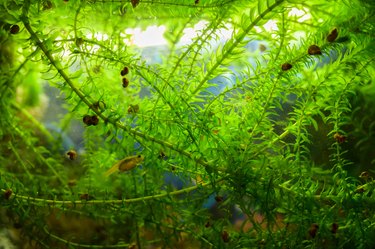
Elodea canadensis (USDA zones 4-10), otherwise known simply as elodea, is an aquatic plant that is native to the North American continent. It is also part of a group of plants known as waterweeds, in part because the introduction of the plant into certain waterways in places like Australia, Europe, Africa and New Zealand have yielded problems. They are considered noxious weeds in these waterways and on these continents, though they are also grown in aquariums for decorative purposes.
Elodea grows very quickly and can reach a mature state within a week. There are several factors that affect the growth rate of elodea.
Video of the Day
Video of the Day
How To Grow Elodea
Soil that consists of silt is likely to grow larger individual elodea plants and is much more likely to grow colonies of elodea. Silt is a type of soil that consists of granular material like sand, or can be similar to a clay mixture. It is different from sand, however, in that it has deposited sediment that is rich in nutrients. Because of this, it provides the most likely source of nutrition for elodea plants, unlike pure sand which is not a very good source of nutrition. Silt can be rich in certain ions, especially iron, and yield stronger and more abundant colonies of elodea.
Other compounds that increase the plant's growth include bicarbonates and phosphorous. Without these substances, elodea growth tends to slow and colonies eventually die out. Soil with an abundance of silt allows elodea plants to grow their shoots at a rapid pace, cutting down their growth rate to less than a week to maturation.
Elodea Plant Temperature Requirements
Elodea plants grow almost entirely in water. The temperature of the water in which it is submerged significantly affects its growth rate, but that does not mean that it is not a sturdy plant. The ideal temperature for elodea ranges from 65 to 75 degrees F (18 to 24 degrees C), but it is able to survive much colder temperatures. Even in icy temperatures during the winter, elodea continues to thrive, though its growth rate significantly drops. When spring comes around, its growth rate gets back to normal.
Effects of Carbon Dioxide
Like all other plants, elodea requires carbon dioxide for metabolism and elodea photosynthesis. Elodea must be in ideal conditions for it to gather enough carbon dioxide to survive. Water that is aerated is essential because it provides air to the elodea. Commonly aerated water is running water, such as streams and creeks.
Carbon dioxide also comes from fish, which expel it when they exhale. Decaying vegetation also stimulates growth because of the breakdown of organic material into carbon compounds. Growth may be slowed, however, if there are other plants competing for carbon dioxide.
Photosynthesis in Elodea
Certainly not the least important, sunlight is a major factor in affecting the growth rate of elodea. Like all other plants, in conjunction with carbon dioxide, it needs sunlight to metabolize and perform photosynthesis. Since elodea resides primarily in water, it needs to be in shallow water for sunlight to reach it. The more shallow the water, the bigger the increase in its growth rate.